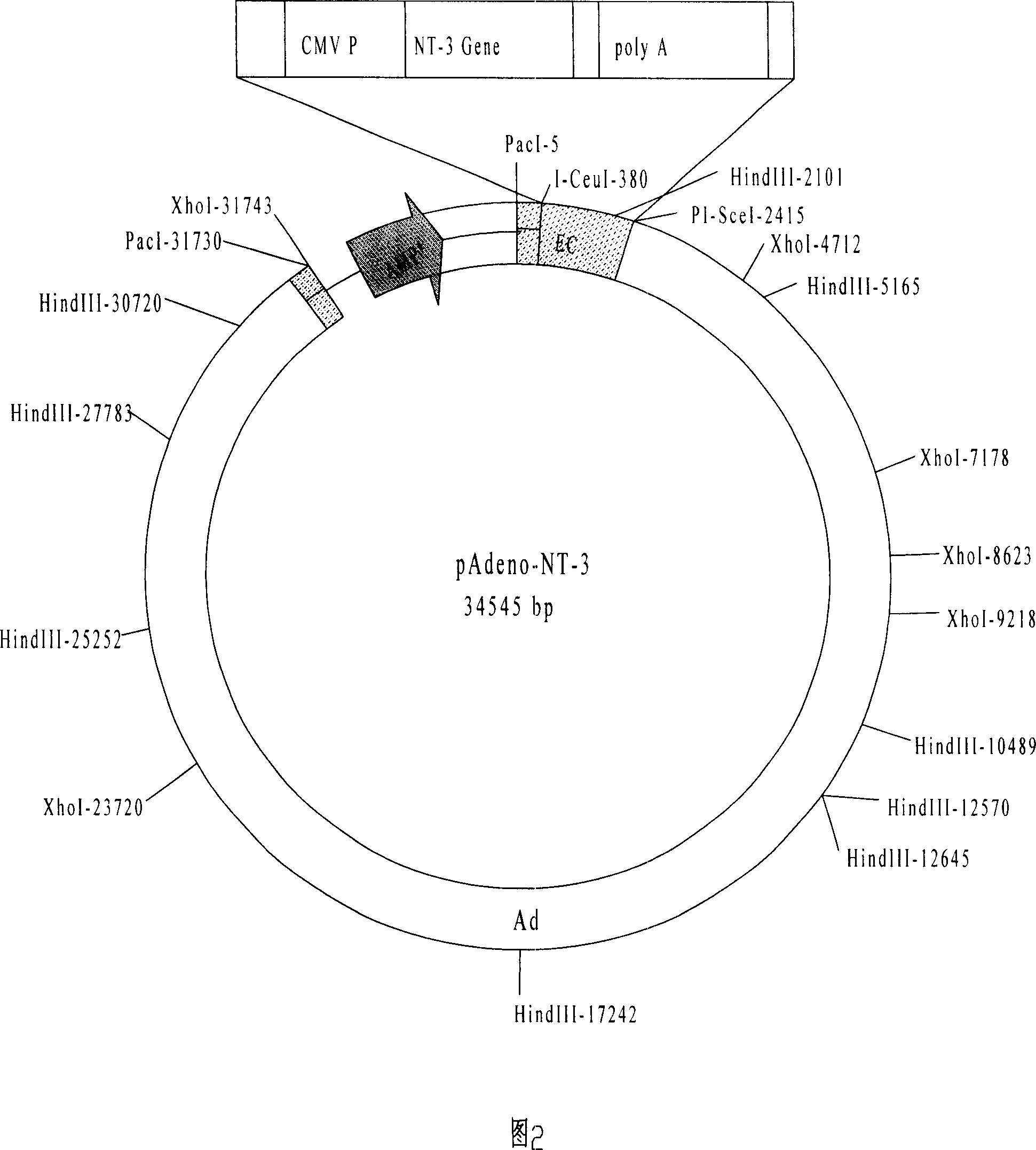Gene recombined virus of human neurenergen 3
A neurotrophin and recombinant virus technology, applied in the field of genetic engineering, to achieve a wide range of hosts, overcome protein instability, and good safety
- Summary
- Abstract
- Description
- Claims
- Application Information
AI Technical Summary
Problems solved by technology
Method used
Image
Examples
Embodiment 1
[0051] Example 1: As shown in Figure 1, Figure 2 and Figure 3, construct recombinant adenovirus
[0052] The recombinant adenovirus expression vector of human neurotrophin-3 (NT-3) gene was constructed.
[0053] The full-length cDNA of NT-3 gene was amplified from human brain tissue mRNA, and cloned in the shuttle plasmid pShuttle to obtain an expression cassette with a CMV promoter. Then the expression cassette was ligated with adenovirus backbone DNA (Adeno-X viral DNA) in vitro to form a recombinant adenovirus plasmid (pAd-NT-3). Human embryonic kidney 293 cells were transfected with pAd-NT-3 and packaged into infectious recombinant adenovirus particles (Adeno-NT-3).
[0054] (1) Primer design and synthesis: The human NT-3 gene was retrieved from GenBank, and primers at both ends were designed for the full length of the gene: 5'-CGTCTAGAACAAGGTGTCCAT-3' and 5'-CAGGTACCAATTCATGTTCTTCCG-3'. The 5′ ends of the upstream and downstream primers contain XbaI and KpnI restriction...
Embodiment 2
[0060] Example 2: Functional identification of recombinant NT-3 adenovirus
[0061] 293 cells were infected with Ad-NT-3, immunocytochemistry, ELISA and Western blot were performed to detect the expression of Ad-NT-3 in vitro.
[0062] (1) Immunocytochemistry: 293 cells were infected with crudely lysed virus liquid, and after about 12 hours of culture, 293 cells were fixed with 4% paraformaldehyde, and rabbit anti-human NT-3 was used as the primary antibody for immunocytochemical staining, and DAB was used for color development. The negative control 293 cells were infected with Ad-LacZ, and the blank control 293 cells were not infected with adenovirus. The results are shown in Figure 9, the 293 cells infected with Ad-NT-3 were strongly positively stained, the 293 cells infected with Ad-LacZ and the 293 cells themselves were negatively stained.
[0063] (2) ELISA: Inoculate 293 cells (4.5×105 cells / well) in a 6-well plate, add Ad-NT-3 virus solution with an MOI of 1, and repla...
Embodiment 3
[0066] Example 3: Effect of Ad-NT-3 on neural stem cell differentiation in vitro
[0067] The implementation materials were divided into 4 groups, group A was NT-3 gene modified Schwann cells + neural stem cells, group B was LacZ gene modified Schwann cells + neural stem cells, group C was Schwann cells + neural stem cells, group D For the pure neural stem cell group.
[0068] A total of 48 wells of two 24-well culture plates were divided into 4 groups with 12 wells in each group, and a sterilized cover glass was added to each well, and plated with poly-lysine. Cultured and purified Schwann cells were trypsinized and made into 2.5×10 4 cells / mL. Add 200 μL of cell suspension to each well of groups A, B, and C, and after culturing for 24 hours, groups A and B were inoculated with Ad-NT-3 and Ad-LacZ according to the above method, group C was not inoculated with adenovirus, and group D was only inoculated with adenovirus. Polylysine decking. The cultured and purified neural ...
PUM
 Login to View More
Login to View More Abstract
Description
Claims
Application Information
 Login to View More
Login to View More - Generate Ideas
- Intellectual Property
- Life Sciences
- Materials
- Tech Scout
- Unparalleled Data Quality
- Higher Quality Content
- 60% Fewer Hallucinations
Browse by: Latest US Patents, China's latest patents, Technical Efficacy Thesaurus, Application Domain, Technology Topic, Popular Technical Reports.
© 2025 PatSnap. All rights reserved.Legal|Privacy policy|Modern Slavery Act Transparency Statement|Sitemap|About US| Contact US: help@patsnap.com



